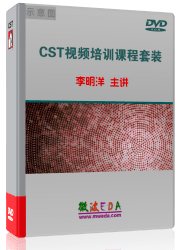负介电常数物质的设置
文章来源: 互联网 录入: mweda.com
我的模型涉及到一个负介电常数物质
不知道怎么设置
介电常数为-1.52+0.0084i
软件提醒好象用色散介质代替,但是色散介质的参数无法确认
有其他方法吗?
微波EDA (www.mweda.com) 网友回复:
-
网友回复
用DRUDE色散模型
你查下帮助 -
网友回复
Dielectric dispersion frame
Dispersion model: Here, different dielectric dispersion models can be chosen, each definable by a different set of specific material properties.
The first material parameter for all dielectric dispersions models is the epsilon infinity value, representing the high frequency limit of the permittivity.
Debye 1st order: The first order Debye dispersion describes a material relaxation process, determined by the relaxation time and the epsilon static value.
Debye 2nd order: The second order Debye dispersion describes a superposed relaxation process given by the summation of two separate first order Debye models. The corresponding parameters are the two relaxation times as well as both epsilon static values.
Drude: The Drude dispersion model describes the dielectric behavior of plasma material, determined by the plasma frequency and the collision frequency representing damping effects.
Lorentz: The Lorentz dispersion model describes a material resonance process, determined by the epsilon static value, the resonance frequency and the damping factor.
Gyrotropic: The electric gyrotropic or so-called gyroelectric dispersion behavior is relevant for magnetized plasma media. The material parameters comprise the plasma frequency and the collision frequency as for the Drude dispersion. In addition, the cyclotron frequency and the biasing direction describe the effect of the homogeneous biasing field. Note that this material dispersion is not selectable for anisotropic material settings.
General 1st order: For a detailed information, see Material Overview.
General 2nd order: For a detailed information, see Material Overview.
User:
The dispersion fit is based either on a constant conductivity, general 1st order, or a general 2st order model. A list of eps' eps'' values can be defined by different frequency points by pressing the Dispersion List button.
Magnetic dispersion frame
Dispersion model: Here, different magnetic dispersion models can be chosen, each definable by a different set of specific material properties.
The first material parameter for all magnetic dispersions models is the mue infinity value, representing the high frequency limit of the permeability.
Debye 1st order: The first order Debye dispersion describes a material relaxation process, determined by the relaxation time and the mue static value.
Debye 2nd order: The second order Debye dispersion describes a superposed relaxation process given by the summation of two separate first order Debye models. The corresponding parameters are the two relaxation times as well as both mue static values.
Drude: The description of this dispersion model corresponds to that of the dielectric material above. However, here this model offers just the possibility to define a specialized dispersion curve, the parameters plasma and collision frequency have no exact physical equivalence.
Lorentz: The Lorentz dispersion model describes a material resonance process, determined by the mue static value, the resonance frequency and the damping factor.
Gyrotropic: The magnetic gyrotropic or so-called gyromagnetic dispersion behavior is relevant for ferrite materials that are magnetized up to saturation by a homogeneous static magnetic field. The corresponding parameters can be defined either in the Gauss or SI unit system. In Gauss units, they are given by the Landé factor, saturation magnetization (4 Pi M), the resonance line width representing the damping effects and finally the external applied magnetic field vector (x,y,z). Using SI units as the input system instead, the parameters are given by the Larmor frequency, the gyrotropic frequency, the damping factor and finally the unit vector for the biasing direction (x,y,z). Note that this material dispersion is not selectable for anisotropic material settings.
See the Material Overview for a description of inhomogeneously biased ferrites.
General 1st order: For a detailed information see Material Overview.
General 2nd order: For a detailed information see Material Overview.
User:
The dispersion fit is based either on a constant conductivity, general 1st order, or a general 2st order model. A list of mue' mue'' values can be defined by different frequency points by pressing the Dispersion List… button.
Parameter conversion frame
Note: This frame is only available for a selected magnetic gyrotropic dispersion model.
System: The Gauss or SI unit system can be selected for different input parameters of the gyrotropic material.
Frequency: Reference frequency for the conversion of material parameters given in Gauss units into the SI system.
See also
Material Parameters, Material Overview (HF), Change Material, Modeller View, Dielectric Dispersion Fit, Magnetic Dispersion Fit -
网友回复
Drude模型里的plasma frequency 和collision frequency 以及epsilon infinity value能从介电常数计算出来吗? -
网友回复
Drude模型里的plasma frequency 和collision frequency以及epsilon infinity value的值能不能直接从介电常数计算出来? -
网友回复
自己顶一下,继续期待高手!
申明:网友回复良莠不齐,仅供参考。如需专业解答,推荐学习李明洋老师的CST培训视频,或咨询本站专家。
-

CST中文视频教程,资深专家讲解,视频操作演示,从基础讲起,循序渐进,并结合最新工程案例,帮您快速学习掌握CST的设计应用...【详细介绍】
推荐课程
-
7套中文视频教程,2本教材,样样经典
-
国内最权威、经典的ADS培训教程套装
-
最全面的微波射频仿真设计培训合集
-
首套Ansoft Designer中文培训教材
-
矢网,频谱仪,信号源...,样样精通
-
与业界连接紧密的课程,学以致用...
-
业界大牛Les Besser的培训课程...
-
Allegro,PADS,PCB设计,其实很简单..
-
Hyperlynx,SIwave,助你解决SI问题
-
现场讲授,实时交流,工作学习两不误


